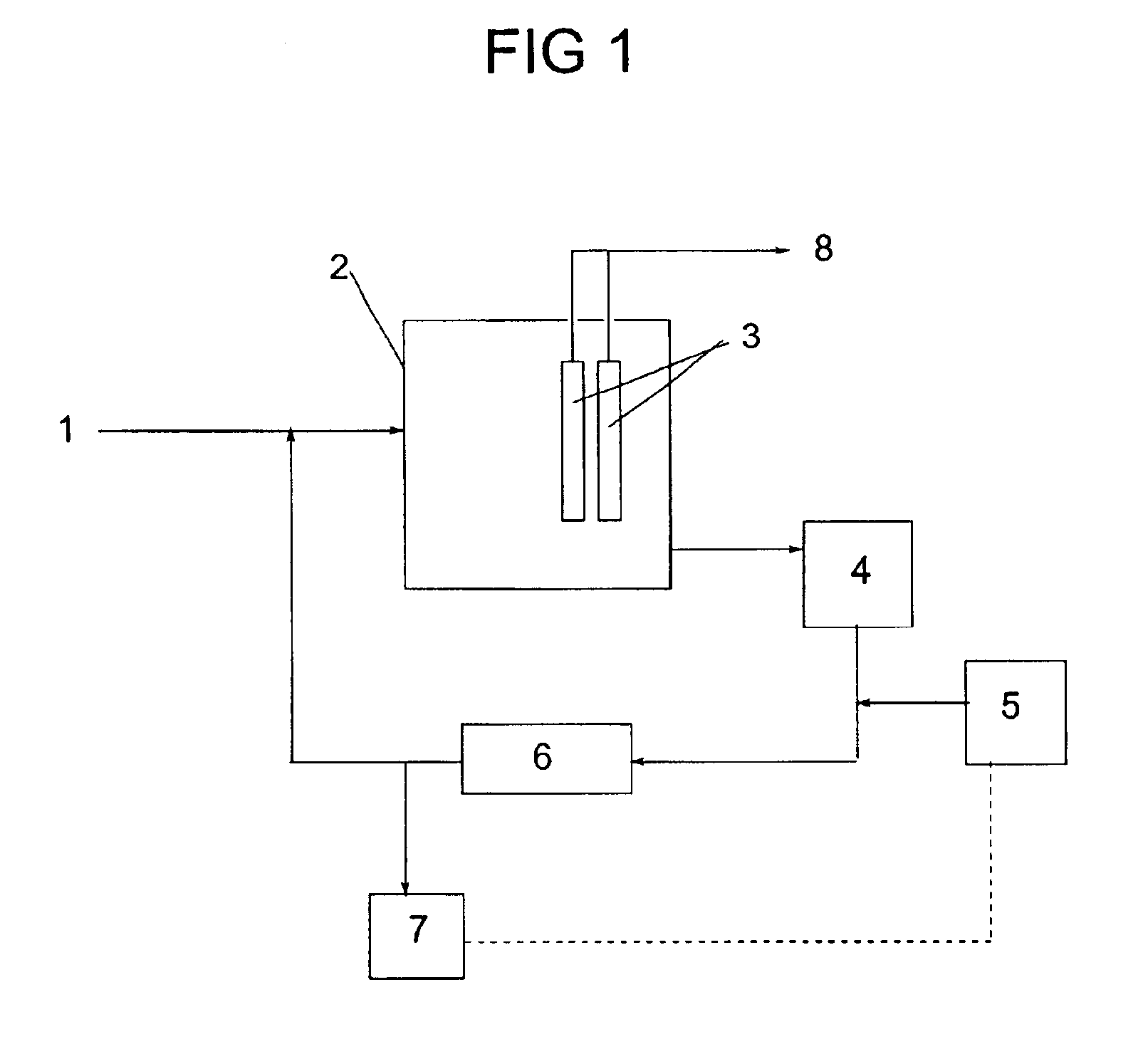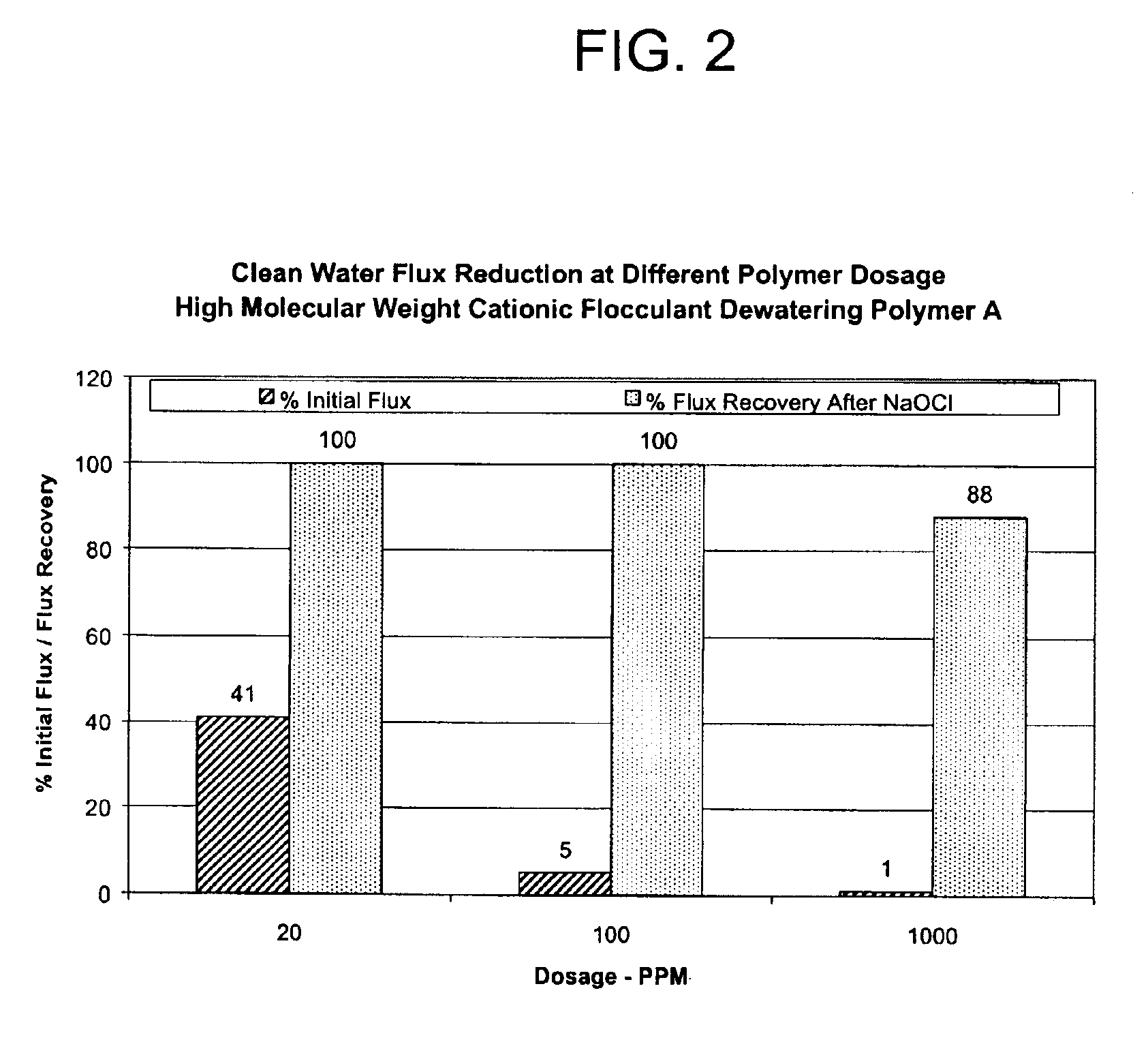Method of using high molecular weight water soluble polymers in membrane bioreactor systems
a bioreactor and high molecular weight technology, applied in the direction of biological water/sewage treatment, sustainable biological treatment, separation processes, etc., can solve the problems of secondary pollution, excessive sludge generation, and particularly difficult maintenan
- Summary
- Abstract
- Description
- Claims
- Application Information
AI Technical Summary
Benefits of technology
Problems solved by technology
Method used
Image
Examples
example 1
Pressure filtration bench tests are conducted to measure the effects of polymer in the filtrate water on membrane fouling. The pressure filtration test is conducted in an Amicon 8400 Stirred Cell (Amicon, Inc., Beverly, Mass.) having a cell capacity of 400 ml, membrane diameter of 43 mm and an effective membrane area of 76 cm2. The membrane is a Kubota chlorinated polyethylene membrane having a negative zeta potential and 0.035 micron pore size. The test is conducted at a pressure of 5 psi and a mixing speed of 300 rpm.
The initial water flux is measured (Jw-initial) after soaking the membrane in polymer solution for 2 days. The membrane is cleaned by rinsing with water and then again measuring the water flux (Jw-final). The water flux (Jw-clean) is also measured after further cleaning by a 30 minute soak in 1000 ppm NaOCl solution. The percent water flux recovery (FR) is then calculated from intial and final water fluxes as:
FR=(Jw-final / Jw-initial)×100 for water washing
or
FR=(Jw-cle...
example 2
Additional filtration tests are conducted using pilot-scale submerged membrane compartments. Each compartment has a capacity of 8 L and contains one Kubota membrane element with an active membrane area of 0.1 m2. The air flow rate for membrane fouling is maintained at 10 L / min and the permeate flux is set at 17 LMH. The rate of membrane fouling is determined from the change in pump suction pressure with time.
FIG. 3 shows the change in pump suction pressure as a function of time and polymer concentration. Higher pump suction pressures are caused by increased membrane fouling. Polymer concentrations of 9 and 30 PPM foul the membrane immediately. Polymer concentrations of 1 and 3 PPM did not appreciably foul the membrane based on the relatively low suction pressures.
example 3
A benchtop test for sludge conditioning is the free drainage test. Using a 500 ml graduated cylinder, a 200 ml aliquot of sludge is dosed with varying amounts of polymer, capped, mixed by inverting the cylinder, and poured onto a filter cloth to drain the liquid from the solids. The filtrate is collected in a beaker and weighed at timed intervals on an electronic, top loading balance. Weight is recorded in 5 second intervals by computer, and the accumulated drainage at 10 seconds is used for comparison of treatment efficacy. The water released from the sludge, called “filtrate” is tested for residual polymer using colloid titration with polyvinylsulfonate potassium salt (PVSK) solution and Toluidine Blue indicator. Additionally, a fluorescent dye, PTSA, is added to the polymer solution before addition to the sludge, and filtrate from the free drainage test is also tested for the dye using a fluorometer (Model TRASAR 3000, Turner Designs, Sunnyvale, Calif.) at the appropriate setting...
PUM
| Property | Measurement | Unit |
|---|---|---|
| pore size | aaaaa | aaaaa |
| molecular weight | aaaaa | aaaaa |
| water soluble | aaaaa | aaaaa |
Abstract
Description
Claims
Application Information
 Login to View More
Login to View More - R&D
- Intellectual Property
- Life Sciences
- Materials
- Tech Scout
- Unparalleled Data Quality
- Higher Quality Content
- 60% Fewer Hallucinations
Browse by: Latest US Patents, China's latest patents, Technical Efficacy Thesaurus, Application Domain, Technology Topic, Popular Technical Reports.
© 2025 PatSnap. All rights reserved.Legal|Privacy policy|Modern Slavery Act Transparency Statement|Sitemap|About US| Contact US: help@patsnap.com



